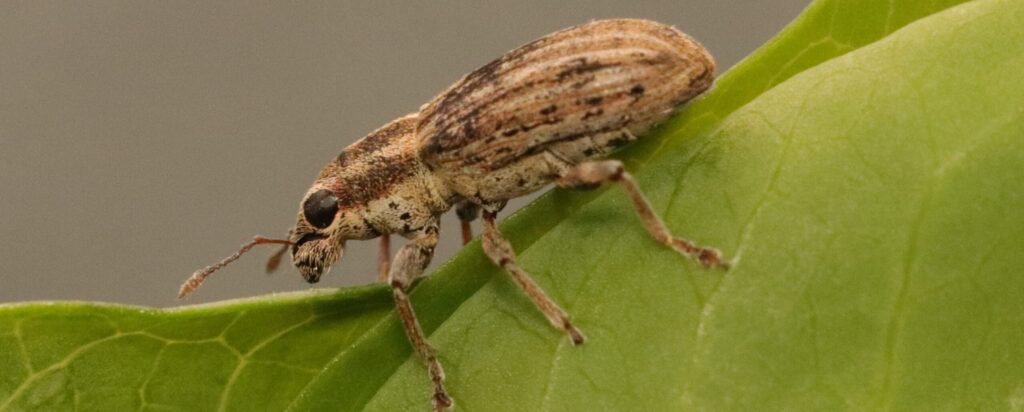In the agricultural ecosystem, insects are represented by two groups: the hungry pests that cause major crop losses, and the beneficial bugs that hunt them (and pollinate plants). Pest insects including grasshoppers, bertha armyworm, diamondback moth and cabbage seedpod weevil are just some of the serious offenders in field crop agriculture, especially in the Prairies. These insects can cause devastating damage to field crops by feeding on leaves, flowers, and seeds. Pests are also expensive foes. Managing an infestation comes with significant costs and damage also impacts the bottom line through reduced crop yields (amount of agricultural product). For example, the flea beetle, a notorious canola pest, can cause crop losses in North America that are likely to exceed $300 million annually. Another offender, the wheat stem sawfly can cause up to $450 million in economic losses in grain crops for the same region. These are just two of the insect pests that Prairie farmers are up against
Crimes of opportunity
Field crops are highly dependent on weather and climate, and so are pest insects. Increased temperatures, longer growing seasons, shifting rainfall patterns and increased extreme events from climate change will create a new environment for opportunistic pests in Western Canada. Longer, warmer summers and milder winters will result in greater overwinter survival of pests as well as a northward expansion of pests not currently found in Canada. While farmers and agronomists can manage pest insects using a variety of controls (such as pesticides, weed management, irrigation practices or natural enemies), early detection of climate change impacts and risk to field crops is critical to making informed decisions.
Dr. Meghan Vankosky, a field crop entomologist with Agriculture and Agri-Food Canada and the Chair of the Prairie Pest Monitoring Network (PPMN), is on the case. Her investigations use historic and current data to model the impacts of climate change on western Canada’s most wanted pest populations and provide insect distribution maps and forecasts so farmers know where these pest criminals can be found.
Pest profiling: Predicting their next move
Dr. Vankosky’s research draws from decades of detective work by the PPMN and builds on its legacy. The network is a group of field crop entomologists who conduct research and actively monitor insect pest populations to support crop protection programs on the Canadian prairies. Established in 1997, the PPMN has developed a vast dataset of pest insect activities in the region with priceless contributions from volunteers including farmers, agronomists, researchers, industry commissions, and provincial experts. The network also uses models to predict when insect pests will be active and to help farmers time their own, on-farm scouting during the growing season. New models for other hungry insect pests that require more investigation are currently in development.
For example, Dr. Vankosky and her team are conducting field and lab experiments to create detailed profiles of the cabbage seedpod weevil, pea leaf weevil and other pest partners in crime. While species like the grasshopper are infamous pests and well-documented, lesser-known pests like the cabbage seedpod weevil and pea leaf weevil can also make a big impact on farmers’ bottom lines. They are also adapting to the changing climate in Western Canada, moving into wetter areas of the province and away from hotter, drought-impacted areas. The information that Dr. Vankosky and her team collect includes examining pest behaviour, growth and population dynamics as well as how the pests interact with other insects and their surroundings, like temperature and rainfall. These clues are necessary to identify the cycles and patterns of pest species, and create the models that predict their next moves.
“Annual in-field insect monitoring and research to understand pest biology and population dynamics is necessary to forecast insect outbreaks from year to year and into the future. Our goal is to conduct research that can be used to help farmers and agronomists stay a step ahead of insect pests on the prairies.”
– Dr. Meghan Vankosky, Research Scientist, Agriculture and Agri-Food Canada
Using the new profile data generated by the project, existing research and surveys from the PPMN, new insect distribution and abundance maps and forecasts can be developed. By cross-referencing models with historic data, new models can be validated and then used to project areas at risk of insect pest damage between 50 and 100 years from now. These tools will better equip farmers and agronomists with the information they need to monitor for pest invasions in areas that are at an elevated risk and plan long-term to reduce the potential for new infestations.
Using deduction, observation and scientific reasoning, Dr. Vankosky is hot on the trail of hungry pest insects, helping farmers protect their crops and their bottom line now and into the future.
Key takeaways
- Climate change will create a new environment for opportunistic insect pests in Western Canada.
- Dr. Meghan Vankosky’s team is using historic and current pest monitoring data to model the impacts of climate change on insect pest species in the prairies and provide high quality insect distribution maps and forecasts to farmers.
- The data generated by this project can validate new models that project areas at risk of insect pest damage between 50 and 100 years into the future.
Photo credit: Jonathan Williams, AAFC
Thank you to Agriculture and Agri-Food Canada for submitting the article and photos.
